Knitted fabrics and types – list of knitted fabrics
Kind of knitted fabrics | Knitted Fabric Names | List of Knitted Fabrics | Type of Knitted Fabrics
Knitting is the construction of an elastic, porous fabric, created by interlocking yarns by means of needles. A list of commonly used knitted fabrics and its construction are explained.
Knitting is the construction of the elastic, porous fabric, created by interlocking yarns by means of needles. Knitted fabrics can be made much more quickly and easily than woven fabrics at comparatively less cost.
Two yarns forming loops in each course of the fabric knit the fabric. Knitting machines form loops of yarn with many pointed needles or shafts. The vertical rows of loops are called ribs or wales, and horizontal rows of loops are called courses.
Knitted fabrics are generally light in weight, comfortable in wear even during travel, but yet require little care to keep their neat appearance. The tendency of knits to resist wrinkling is another factor to boost up their popularity.
Knitted fabrics are used for designing active clothing such as sports clothing. Their elastic nature permits for abundant physical activity.
Knit Schematics
Weft or filling knits are constructed from one yarn that is fed into knitting machine needles in a horizontal direction.
The circular knitting machine creates a spiral effect as it produces a fabric in tabular form. Because of this spiral characteristic, it is often difficult to have the wales and courses of the knit fabric form a perfect 90-degree angle match.
Knitted fabrics are produced by two general methods – warp knitting, and weft knitting, and each method produces a variety of types of knitted fabrics.
Runtang Textile is a manufacturer specializing in the production of high-quality knitted fabrics.
Knitted Fabric Knits
- Weft Knits
- Single Knits
- Single Jersey
- Lacoste
- Double Knits
- Rib Knit
- Purl Knit
- Interlock Knit
- Cable Fabric
- Bird’s Eye
- Cardigans
- Milano Ribs
- Pointelle
- Single Knits
- Specialized Weft Knits
- Intarsia
- Jacquard Jerseys
- Knitted Terry
- Knitted Velour
- Sliver Knit
- Fleece
- French Terry
- Warp Knits
- Tricot
- Raschel
Either a circular or a flat-bed knitting machine can be used to make weft knits. Four basic stitches are used in the weft of filling knits.
- Jersey stitch/plain knit
- Purl stitch
- Rib stitch
- Interlock stitch (both for single and double knits)
Knitted Fabric Types
See also: Type of Woven Fabrics
-
Flat or Jersey Knit Fabric
![flat-jersey-knit]() Flat or Jersey Knit fabrics have visible flat vertical lines on the front and dominant horizontal ribs on the back of the fabric. The flat or jersey knit stitch is used frequently, it is fast, inexpensive, and can be varied to produce fancy patterned fabrics. A major disadvantage of regular flat knits is their tendency to “run” if a yarn is broken. The flat or jersey stitch can be varied by using different yarns or double-looped stitches of different lengths to make terry, velour, and plush fabrics. This stitch is also used in making nylon hosiery, men’s underwear, and t-shirts.
Flat or Jersey Knit fabrics have visible flat vertical lines on the front and dominant horizontal ribs on the back of the fabric. The flat or jersey knit stitch is used frequently, it is fast, inexpensive, and can be varied to produce fancy patterned fabrics. A major disadvantage of regular flat knits is their tendency to “run” if a yarn is broken. The flat or jersey stitch can be varied by using different yarns or double-looped stitches of different lengths to make terry, velour, and plush fabrics. This stitch is also used in making nylon hosiery, men’s underwear, and t-shirts. -
Purl Knit Fabric
![purl-knit]() Purl Knit Fabrics look the same on both sides of the fabric. Many attractive patterns and designs can be created with the purl stitch. It is often used in the manufacture of bulky sweaters and children’s clothing. The production speed is generally slow with Purl knits.
Purl Knit Fabrics look the same on both sides of the fabric. Many attractive patterns and designs can be created with the purl stitch. It is often used in the manufacture of bulky sweaters and children’s clothing. The production speed is generally slow with Purl knits.Purl Knit is made by knitting yarn as alternate knit and purl stitch in one wale of the fabric. The fabric has alternate courses of knit stitch and purl stitch. The fabric is reversible and identical on both sides of the fabric. The fabric does not curl and lies flat. It is more stretchable in length direction.
-
Rib Stitch Knit Fabric
![rib-knit]() Rib Stitch Knits have stitches drawn to both sides of the fabric, which produces columns of wales on both the front and back of the fabric. Rib stitch produces fabrics that have excellent elasticity. Rib knits are used for the “ribbing” which is usually found at the lower edges of sweaters, on sleeve cuffs, and at necklines. The Rib-knit fabric is made by knitting yarn as alternate knit stitch and purl stitch in one course of the fabric. The fabric has alternate wales of knit and purl stitches. It is reversible fabric, as they look identical on both sides of the fabric. They may be made with both flat and circular knitting machines.
Rib Stitch Knits have stitches drawn to both sides of the fabric, which produces columns of wales on both the front and back of the fabric. Rib stitch produces fabrics that have excellent elasticity. Rib knits are used for the “ribbing” which is usually found at the lower edges of sweaters, on sleeve cuffs, and at necklines. The Rib-knit fabric is made by knitting yarn as alternate knit stitch and purl stitch in one course of the fabric. The fabric has alternate wales of knit and purl stitches. It is reversible fabric, as they look identical on both sides of the fabric. They may be made with both flat and circular knitting machines.-
Cardigans
Cardigans are a variation of Rib Knit with half Cardigan and Full Cardigan varieties. The fabric has specific patterns of tuck stitches. These produce a raised effect and hence, cardigans are a thicker fabric.
-
Half Cardigan
The Half Cardigan is made of one course of all knit on both needle beds and second course of all knit on front needles and all tuck on back needles. The tuck loops present in the fabric reduce the stretch in width direction. It is not reversible fabric. They are generally coarsely knitted and used for making pullovers and sweaters.
-
Full Cardigan
The Full Cardigan is made of a repeat of one course of all knit on front needles and all tuck on back needles, the second course of all tuck on front needles and all knit on back needles. Full Cardigan looks identical on both sides. Excessive tuck loops make the fabric bulky and thick. It is usually knitted in coarser gauge and widely used in making sweaters and fashion garments. Cardigans are usually made of Wool or Acrylic.
-
-
Milano Ribs
Milano Ribs are a variant of Rib Knit with half Milano and full Milano variations. The fabric has specific patterns of knitting and misses.
-
Half Milano
Half Milano is made of a repeat of one course of all knit on both needle beds and second course of all knit on front needles only. It has an unbalanced structure. It is usually knitted coarse gauge and widely used for making sweaters.
-
Full Milano
Full Milano is made of a repeat of one course of all knit on both needle beds, the second course of all knit on front needles only and the third course of all knit on back needles only. Full Milano is finely knitted fabric and has better coverage. It has greater dimensional stability than half Milano rib. It is widely used as suiting fabrics.
-
-
-
Interlock Stitch Knit Fabric
![interlocking-knit]() Interlock stitch Knits are variations of rib stitch knits. The front and back of interlocks are the same. These fabrics are usually heavier and thicker than regular rib knit fabrics unless used with finer yarns. The interlocking of stitches prevents runs and produces apparel fabrics that do not ravel or curl at the edges.
Interlock stitch Knits are variations of rib stitch knits. The front and back of interlocks are the same. These fabrics are usually heavier and thicker than regular rib knit fabrics unless used with finer yarns. The interlocking of stitches prevents runs and produces apparel fabrics that do not ravel or curl at the edges. -
Double Knit Fabric
![double-knit]() Double Knits are made from the interlock stitches and its variations. The process involves the use of two pairs of needles set at an angle to each other. Fibers that the generally used to make double knits are polyester and wool. Double knits are weft knitted fabrics made with two sets of needle beds. The fabric structure is more stable and compact. The fabrics do not curl at the edges and do not ravel. They may be made with interesting designs and textures. One or two yarns are used to knit one course in the fabric.
Double Knits are made from the interlock stitches and its variations. The process involves the use of two pairs of needles set at an angle to each other. Fibers that the generally used to make double knits are polyester and wool. Double knits are weft knitted fabrics made with two sets of needle beds. The fabric structure is more stable and compact. The fabrics do not curl at the edges and do not ravel. They may be made with interesting designs and textures. One or two yarns are used to knit one course in the fabric. -
Warp Knitted Fabric
![warp-knit]() Warp knitted fabrics are made in a special knitting machine with yarns from warp beam. Unlike weft knits, they are knitted from multiple yarns, with yarns forming loops in adjacent wales. The fabric may be identified with a pick glass. The face side of the fabric has slightly inclined vertical knitting loops whereas the backside of the fabric has inclined horizontal floats. They do not ravel. Warp knit fabrics are constructed with yarn loops formed in a vertical or warp direction. All the yarns used for a width of a warp knit are placed parallel to each other in a manner similar to the placement of yarns in weaving. The fabrics that are made of great quality with the technique are generally made with Tricot and Raschel knits.
Warp knitted fabrics are made in a special knitting machine with yarns from warp beam. Unlike weft knits, they are knitted from multiple yarns, with yarns forming loops in adjacent wales. The fabric may be identified with a pick glass. The face side of the fabric has slightly inclined vertical knitting loops whereas the backside of the fabric has inclined horizontal floats. They do not ravel. Warp knit fabrics are constructed with yarn loops formed in a vertical or warp direction. All the yarns used for a width of a warp knit are placed parallel to each other in a manner similar to the placement of yarns in weaving. The fabrics that are made of great quality with the technique are generally made with Tricot and Raschel knits. -
Tricot Knit Fabric
![tricot-knit]() Tricot knits are made almost exclusively from filament yarns because uniform diameter and high quality are essential yarn characteristics for use with the very high-speed tricot knitting machines. Fabrics constructed by the tricot knitting machine are usually plain or have a simple geometric design. The front surface of the fabric has clearly defined vertical wales, and the back surface has crosswise courses.
Tricot knits are made almost exclusively from filament yarns because uniform diameter and high quality are essential yarn characteristics for use with the very high-speed tricot knitting machines. Fabrics constructed by the tricot knitting machine are usually plain or have a simple geometric design. The front surface of the fabric has clearly defined vertical wales, and the back surface has crosswise courses. -
Raschel Knit Fabric
![raschel-knit]() Raschel knits are produced from spun or filament yarns of different weights and types. Most raschel knits can be identified by their intricate designs, the open-space look of crochet or lace, and an almost three-dimensional surface effect design.
Raschel knits are produced from spun or filament yarns of different weights and types. Most raschel knits can be identified by their intricate designs, the open-space look of crochet or lace, and an almost three-dimensional surface effect design. -
Cable Knit Fabric
![cable-knit]() Cable fabric is a double knit fabric made by the special loop transfer technique. The wales in the fabric have a rope-like an appearance, where plaits are based on the transfer of loops with adjacent wales. The fabric has an interesting surface texture like braids as the loops cross each other. It is widely used as sweater fabric.
Cable fabric is a double knit fabric made by the special loop transfer technique. The wales in the fabric have a rope-like an appearance, where plaits are based on the transfer of loops with adjacent wales. The fabric has an interesting surface texture like braids as the loops cross each other. It is widely used as sweater fabric. -
Bird’s Eye Knit Fabric
![birds-eye-knit]() Bird’s eye is a double knit fabric with a combination of tuck stitches along with knitting stitches. The tuck stitch creates interesting eyelet or hole effect on the fabric surface resembling a bird’s eye. FabThe fabric usually made of multi-colored threads creating scrambling effect. The fabric may be made with designs having eyelets. They are a popular clothing fabric, especially women’s wear.
Bird’s eye is a double knit fabric with a combination of tuck stitches along with knitting stitches. The tuck stitch creates interesting eyelet or hole effect on the fabric surface resembling a bird’s eye. FabThe fabric usually made of multi-colored threads creating scrambling effect. The fabric may be made with designs having eyelets. They are a popular clothing fabric, especially women’s wear. -
Pointelle Knit Fabric
![pointelle-knit]() Pointelle is a type of double knit fabric. The fabric has patterned miss stitches. The fabric has looked like lace, with holes made by these transferred stitches. The feminine look of the fabric makes it ideal for women’s tops and kids wear.
Pointelle is a type of double knit fabric. The fabric has patterned miss stitches. The fabric has looked like lace, with holes made by these transferred stitches. The feminine look of the fabric makes it ideal for women’s tops and kids wear. -
Intarsia Knit Fabric
![Intarsia-Knit]() Intarsia is patterned single knit fabric. It is made of knitting multi-colored yarns. The fabric has the same course knitted in different colors with different yarns. It has colored designs as blocks distributed in different color backgrounds. The patterns look identical on both the face and backside of the fabric. There are no floats found on the backside of the fabric. It is typically used to make shirts, blouses, and sweaters.
Intarsia is patterned single knit fabric. It is made of knitting multi-colored yarns. The fabric has the same course knitted in different colors with different yarns. It has colored designs as blocks distributed in different color backgrounds. The patterns look identical on both the face and backside of the fabric. There are no floats found on the backside of the fabric. It is typically used to make shirts, blouses, and sweaters. -
Jacquard Knit Fabric
![Jacquard-Knit]() Jacquard Jerseys are single jersey fabrics made of Circular Knitting machines using Jacquard mechanism. They are the simplest method of making patterned fabrics. They are produced with interesting patterns, which may have any of the following:
Jacquard Jerseys are single jersey fabrics made of Circular Knitting machines using Jacquard mechanism. They are the simplest method of making patterned fabrics. They are produced with interesting patterns, which may have any of the following:- Combinations of stitches, or
- Combinations of yarn types in terms of color textures etc.
Jacquard fabrics have different colored loops made of different threads in the same course. Floats are an inherent feature of single jersey jacquards. They are widely used in the sweater industry.
-
Knitted Terry Fabric
![knitted-terry]() Knitted Terry is pile jersey fabric made with a special attachment in regular
Knitted Terry is pile jersey fabric made with a special attachment in regular
circular knitting machines similar to woven fabrics. The fabric has loops on the fabric surface. The fabric is made of two sets of yarns, in which one set of yarn makes the pile, while the other set of yarn makes the base fabric.
Knit terry is softer, more flexible and is more comfortable than woven terry fabrics. However, they are not firm and durable as woven terry. Owing to its softness and absorbency, it is widely used in beachwear, towels, bathrobes etc.-
French Terry Fabric
French Terry It is a type of Weft Insertion Jersey. The piles on the fabric are not napped and the technical back of the fabric is used as face side. French Terry has loops or piles on one side only. The piles of the French Terry are much shorter when compared to usual Terry. The fabric has excellent stretch and gives fleece like a handle. These features make the fabric more comfortable hence, they are popularly used in clothing, especially infants and kids. French Terry is widely used in sportswear, jogging suits and workout suits owing to its absorbency and stretch.
-
-
Knitted Velour Fabric
![Knitted-Velour-knit]() Knitted Velour are Pile jersey fabrics having soft protruding fibers on the fabric surface. Like knit terry, they are also made of an additional set of yarns making pile loops on the fabric surface. However, in Velour, these pile loops are sheared evenly and brushed. It may be dyed and generally available with solid colors. They are used in luxurious apparels like jackets, blouses, dresses etc.
Knitted Velour are Pile jersey fabrics having soft protruding fibers on the fabric surface. Like knit terry, they are also made of an additional set of yarns making pile loops on the fabric surface. However, in Velour, these pile loops are sheared evenly and brushed. It may be dyed and generally available with solid colors. They are used in luxurious apparels like jackets, blouses, dresses etc. -
Sliver Knit Fabric
![sliver-knit]() The Sliver Knit is Pile jersey fabric. Unlike Velour fabric, Sliver knit fabric is characterized by a longer pile on the fabric surface. It is made of special circular knitting machines in which the surface fibers imitating fur are attached to the fabric, by means of knitting sliver along with base yarn making the fabric. Sliver knit fabrics have longer and denser piles on the fabric surface than other pile jerseys. Animal printed sliver knit fabrics are popularly used as imitation fur fabrics. They are more popular than fur as they are light, more stretchable and do not require special care for storage. They are widely used in making jackets and coats.
The Sliver Knit is Pile jersey fabric. Unlike Velour fabric, Sliver knit fabric is characterized by a longer pile on the fabric surface. It is made of special circular knitting machines in which the surface fibers imitating fur are attached to the fabric, by means of knitting sliver along with base yarn making the fabric. Sliver knit fabrics have longer and denser piles on the fabric surface than other pile jerseys. Animal printed sliver knit fabrics are popularly used as imitation fur fabrics. They are more popular than fur as they are light, more stretchable and do not require special care for storage. They are widely used in making jackets and coats. -
Fleece Knit Fabric
![fleece-knit]() Fleece is a type of weft insertion jersey. Weft insertion fabrics are weft knitted fabrics in which an additional yarn is inserted for each course. These additional yarns are not knit, rather they are held by the loops in each course of the fabric. The inserted yarn may be decorative or functional like stretch yarn. It provides stability, cover, and comfort. The insertion yarn is usually coarser than the base yarn. When the insertion yarn forming piles are sheared and napped, it is called Fleece. They are usually made of Cotton, Cotton/Polyester, Wool, and Acrylic. End Uses include jackets, dresses, sportswear, and sweaters.
Fleece is a type of weft insertion jersey. Weft insertion fabrics are weft knitted fabrics in which an additional yarn is inserted for each course. These additional yarns are not knit, rather they are held by the loops in each course of the fabric. The inserted yarn may be decorative or functional like stretch yarn. It provides stability, cover, and comfort. The insertion yarn is usually coarser than the base yarn. When the insertion yarn forming piles are sheared and napped, it is called Fleece. They are usually made of Cotton, Cotton/Polyester, Wool, and Acrylic. End Uses include jackets, dresses, sportswear, and sweaters.



 Flat or Jersey Knit fabrics have visible flat vertical lines on the front and dominant horizontal ribs on the back of the fabric. The flat or jersey knit stitch is used frequently, it is fast, inexpensive, and can be varied to produce fancy patterned fabrics. A major disadvantage of regular flat knits is their tendency to “run” if a yarn is broken. The flat or jersey stitch can be varied by using different yarns or double-looped stitches of different lengths to make terry, velour, and plush fabrics. This stitch is also used in making nylon hosiery, men’s underwear, and t-shirts.
Flat or Jersey Knit fabrics have visible flat vertical lines on the front and dominant horizontal ribs on the back of the fabric. The flat or jersey knit stitch is used frequently, it is fast, inexpensive, and can be varied to produce fancy patterned fabrics. A major disadvantage of regular flat knits is their tendency to “run” if a yarn is broken. The flat or jersey stitch can be varied by using different yarns or double-looped stitches of different lengths to make terry, velour, and plush fabrics. This stitch is also used in making nylon hosiery, men’s underwear, and t-shirts. Purl Knit Fabrics look the same on both sides of the fabric. Many attractive patterns and designs can be created with the purl stitch. It is often used in the manufacture of bulky sweaters and children’s clothing. The production speed is generally slow with Purl knits.
Purl Knit Fabrics look the same on both sides of the fabric. Many attractive patterns and designs can be created with the purl stitch. It is often used in the manufacture of bulky sweaters and children’s clothing. The production speed is generally slow with Purl knits. Rib Stitch Knits have stitches drawn to both sides of the fabric, which produces columns of wales on both the front and back of the fabric. Rib stitch produces fabrics that have excellent elasticity. Rib knits are used for the “ribbing” which is usually found at the lower edges of sweaters, on sleeve cuffs, and at necklines. The Rib-knit fabric is made by knitting yarn as alternate knit stitch and purl stitch in one course of the fabric. The fabric has alternate wales of knit and purl stitches. It is reversible fabric, as they look identical on both sides of the fabric. They may be made with both flat and circular knitting machines.
Rib Stitch Knits have stitches drawn to both sides of the fabric, which produces columns of wales on both the front and back of the fabric. Rib stitch produces fabrics that have excellent elasticity. Rib knits are used for the “ribbing” which is usually found at the lower edges of sweaters, on sleeve cuffs, and at necklines. The Rib-knit fabric is made by knitting yarn as alternate knit stitch and purl stitch in one course of the fabric. The fabric has alternate wales of knit and purl stitches. It is reversible fabric, as they look identical on both sides of the fabric. They may be made with both flat and circular knitting machines.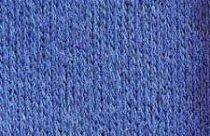 Interlock stitch Knits are variations of rib stitch knits. The front and back of interlocks are the same. These fabrics are usually heavier and thicker than regular rib knit fabrics unless used with finer yarns. The interlocking of stitches prevents runs and produces apparel fabrics that do not ravel or curl at the edges.
Interlock stitch Knits are variations of rib stitch knits. The front and back of interlocks are the same. These fabrics are usually heavier and thicker than regular rib knit fabrics unless used with finer yarns. The interlocking of stitches prevents runs and produces apparel fabrics that do not ravel or curl at the edges. Double Knits are made from the interlock stitches and its variations. The process involves the use of two pairs of needles set at an angle to each other. Fibers that the generally used to make double knits are polyester and wool. Double knits are weft knitted fabrics made with two sets of needle beds. The fabric structure is more stable and compact. The fabrics do not curl at the edges and do not ravel. They may be made with interesting designs and textures. One or two yarns are used to knit one course in the fabric.
Double Knits are made from the interlock stitches and its variations. The process involves the use of two pairs of needles set at an angle to each other. Fibers that the generally used to make double knits are polyester and wool. Double knits are weft knitted fabrics made with two sets of needle beds. The fabric structure is more stable and compact. The fabrics do not curl at the edges and do not ravel. They may be made with interesting designs and textures. One or two yarns are used to knit one course in the fabric.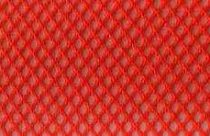 Warp knitted fabrics are made in a special knitting machine with yarns from warp beam. Unlike weft knits, they are knitted from multiple yarns, with yarns forming loops in adjacent wales. The fabric may be identified with a pick glass. The face side of the fabric has slightly inclined vertical knitting loops whereas the backside of the fabric has inclined horizontal floats. They do not ravel. Warp knit fabrics are constructed with yarn loops formed in a vertical or warp direction. All the yarns used for a width of a warp knit are placed parallel to each other in a manner similar to the placement of yarns in weaving. The fabrics that are made of great quality with the technique are generally made with Tricot and Raschel knits.
Warp knitted fabrics are made in a special knitting machine with yarns from warp beam. Unlike weft knits, they are knitted from multiple yarns, with yarns forming loops in adjacent wales. The fabric may be identified with a pick glass. The face side of the fabric has slightly inclined vertical knitting loops whereas the backside of the fabric has inclined horizontal floats. They do not ravel. Warp knit fabrics are constructed with yarn loops formed in a vertical or warp direction. All the yarns used for a width of a warp knit are placed parallel to each other in a manner similar to the placement of yarns in weaving. The fabrics that are made of great quality with the technique are generally made with Tricot and Raschel knits.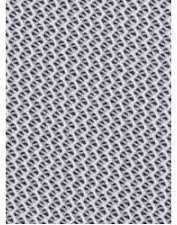 Tricot knits are made almost exclusively from filament yarns because uniform diameter and high quality are essential yarn characteristics for use with the very high-speed tricot knitting machines. Fabrics constructed by the tricot knitting machine are usually plain or have a simple geometric design. The front surface of the fabric has clearly defined vertical wales, and the back surface has crosswise courses.
Tricot knits are made almost exclusively from filament yarns because uniform diameter and high quality are essential yarn characteristics for use with the very high-speed tricot knitting machines. Fabrics constructed by the tricot knitting machine are usually plain or have a simple geometric design. The front surface of the fabric has clearly defined vertical wales, and the back surface has crosswise courses. Raschel knits are produced from spun or filament yarns of different weights and types. Most raschel knits can be identified by their intricate designs, the open-space look of crochet or lace, and an almost three-dimensional surface effect design.
Raschel knits are produced from spun or filament yarns of different weights and types. Most raschel knits can be identified by their intricate designs, the open-space look of crochet or lace, and an almost three-dimensional surface effect design.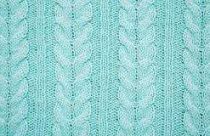 Cable fabric is a double knit fabric made by the special loop transfer technique. The wales in the fabric have a rope-like an appearance, where plaits are based on the transfer of loops with adjacent wales. The fabric has an interesting surface texture like braids as the loops cross each other. It is widely used as sweater fabric.
Cable fabric is a double knit fabric made by the special loop transfer technique. The wales in the fabric have a rope-like an appearance, where plaits are based on the transfer of loops with adjacent wales. The fabric has an interesting surface texture like braids as the loops cross each other. It is widely used as sweater fabric.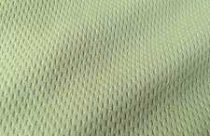 Bird’s eye is a double knit fabric with a combination of tuck stitches along with knitting stitches. The tuck stitch creates interesting eyelet or hole effect on the fabric surface resembling a bird’s eye. FabThe fabric usually made of multi-colored threads creating scrambling effect. The fabric may be made with designs having eyelets. They are a popular clothing fabric, especially women’s wear.
Bird’s eye is a double knit fabric with a combination of tuck stitches along with knitting stitches. The tuck stitch creates interesting eyelet or hole effect on the fabric surface resembling a bird’s eye. FabThe fabric usually made of multi-colored threads creating scrambling effect. The fabric may be made with designs having eyelets. They are a popular clothing fabric, especially women’s wear.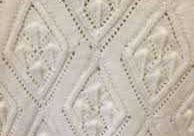 Pointelle is a type of double knit fabric. The fabric has patterned miss stitches. The fabric has looked like lace, with holes made by these transferred stitches. The feminine look of the fabric makes it ideal for women’s tops and kids wear.
Pointelle is a type of double knit fabric. The fabric has patterned miss stitches. The fabric has looked like lace, with holes made by these transferred stitches. The feminine look of the fabric makes it ideal for women’s tops and kids wear.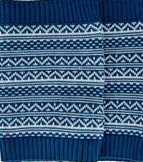 Intarsia is patterned single knit fabric. It is made of knitting multi-colored yarns. The fabric has the same course knitted in different colors with different yarns. It has colored designs as blocks distributed in different color backgrounds. The patterns look identical on both the face and backside of the fabric. There are no floats found on the backside of the fabric. It is typically used to make shirts, blouses, and sweaters.
Intarsia is patterned single knit fabric. It is made of knitting multi-colored yarns. The fabric has the same course knitted in different colors with different yarns. It has colored designs as blocks distributed in different color backgrounds. The patterns look identical on both the face and backside of the fabric. There are no floats found on the backside of the fabric. It is typically used to make shirts, blouses, and sweaters. Jacquard Jerseys are single jersey fabrics made of Circular Knitting machines using Jacquard mechanism. They are the simplest method of making patterned fabrics. They are produced with interesting patterns, which may have any of the following:
Jacquard Jerseys are single jersey fabrics made of Circular Knitting machines using Jacquard mechanism. They are the simplest method of making patterned fabrics. They are produced with interesting patterns, which may have any of the following: Knitted Terry is pile jersey fabric made with a special attachment in regular
Knitted Terry is pile jersey fabric made with a special attachment in regular Knitted Velour are Pile jersey fabrics having soft protruding fibers on the fabric surface. Like knit terry, they are also made of an additional set of yarns making pile loops on the fabric surface. However, in Velour, these pile loops are sheared evenly and brushed. It may be dyed and generally available with solid colors. They are used in luxurious apparels like jackets, blouses, dresses etc.
Knitted Velour are Pile jersey fabrics having soft protruding fibers on the fabric surface. Like knit terry, they are also made of an additional set of yarns making pile loops on the fabric surface. However, in Velour, these pile loops are sheared evenly and brushed. It may be dyed and generally available with solid colors. They are used in luxurious apparels like jackets, blouses, dresses etc.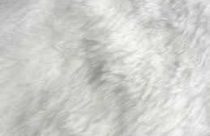 The Sliver Knit is Pile jersey fabric. Unlike Velour fabric, Sliver knit fabric is characterized by a longer pile on the fabric surface. It is made of special circular knitting machines in which the surface fibers imitating fur are attached to the fabric, by means of knitting sliver along with base yarn making the fabric. Sliver knit fabrics have longer and denser piles on the fabric surface than other pile jerseys. Animal printed sliver knit fabrics are popularly used as imitation fur fabrics. They are more popular than fur as they are light, more stretchable and do not require special care for storage. They are widely used in making jackets and coats.
The Sliver Knit is Pile jersey fabric. Unlike Velour fabric, Sliver knit fabric is characterized by a longer pile on the fabric surface. It is made of special circular knitting machines in which the surface fibers imitating fur are attached to the fabric, by means of knitting sliver along with base yarn making the fabric. Sliver knit fabrics have longer and denser piles on the fabric surface than other pile jerseys. Animal printed sliver knit fabrics are popularly used as imitation fur fabrics. They are more popular than fur as they are light, more stretchable and do not require special care for storage. They are widely used in making jackets and coats.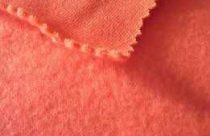 Fleece is a type of weft insertion jersey. Weft insertion fabrics are weft knitted fabrics in which an additional yarn is inserted for each course. These additional yarns are not knit, rather they are held by the loops in each course of the fabric. The inserted yarn may be decorative or functional like stretch yarn. It provides stability, cover, and comfort. The insertion yarn is usually coarser than the base yarn. When the insertion yarn forming piles are sheared and napped, it is called Fleece. They are usually made of Cotton, Cotton/Polyester, Wool, and Acrylic. End Uses include jackets, dresses, sportswear, and sweaters.
Fleece is a type of weft insertion jersey. Weft insertion fabrics are weft knitted fabrics in which an additional yarn is inserted for each course. These additional yarns are not knit, rather they are held by the loops in each course of the fabric. The inserted yarn may be decorative or functional like stretch yarn. It provides stability, cover, and comfort. The insertion yarn is usually coarser than the base yarn. When the insertion yarn forming piles are sheared and napped, it is called Fleece. They are usually made of Cotton, Cotton/Polyester, Wool, and Acrylic. End Uses include jackets, dresses, sportswear, and sweaters.
Hello,
I have a lot of material for bobbin lace or other textile works for sale.If you are interested ,I wil lsend you somepictures.My mom is famous artist in Slovakia,and she does not use it anymore..linen thread,hemp yarn, bobbin lace sticks…
Very Nice content.
Its informative too.
Very informative. Thanks a lot for giving your precious time to knowledge sharing.
I Want to learn textile study, tks a lot for the details
Thanks for sharing knowledge.
Pretty! This has been an extremely wonderful article. Thanks for providing these details.
Having read this I believed it was very informative. I appreciate you spending some time and effort to put this short article together. I once again find myself spending a significant amount of time both reading and leaving comments. But so what, it was still worthwhile!
That is a good tip particularly to those fresh to the blogosphere. Simple but very precise info… Thank you for sharing this one. A must read article!
How can we order
Good discription on topics
Many many thanks, good job
I want learn textile study